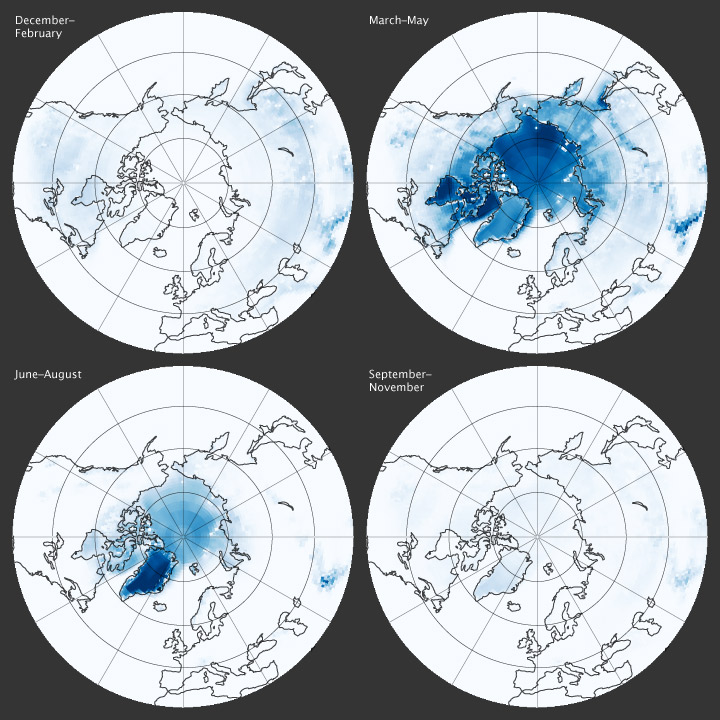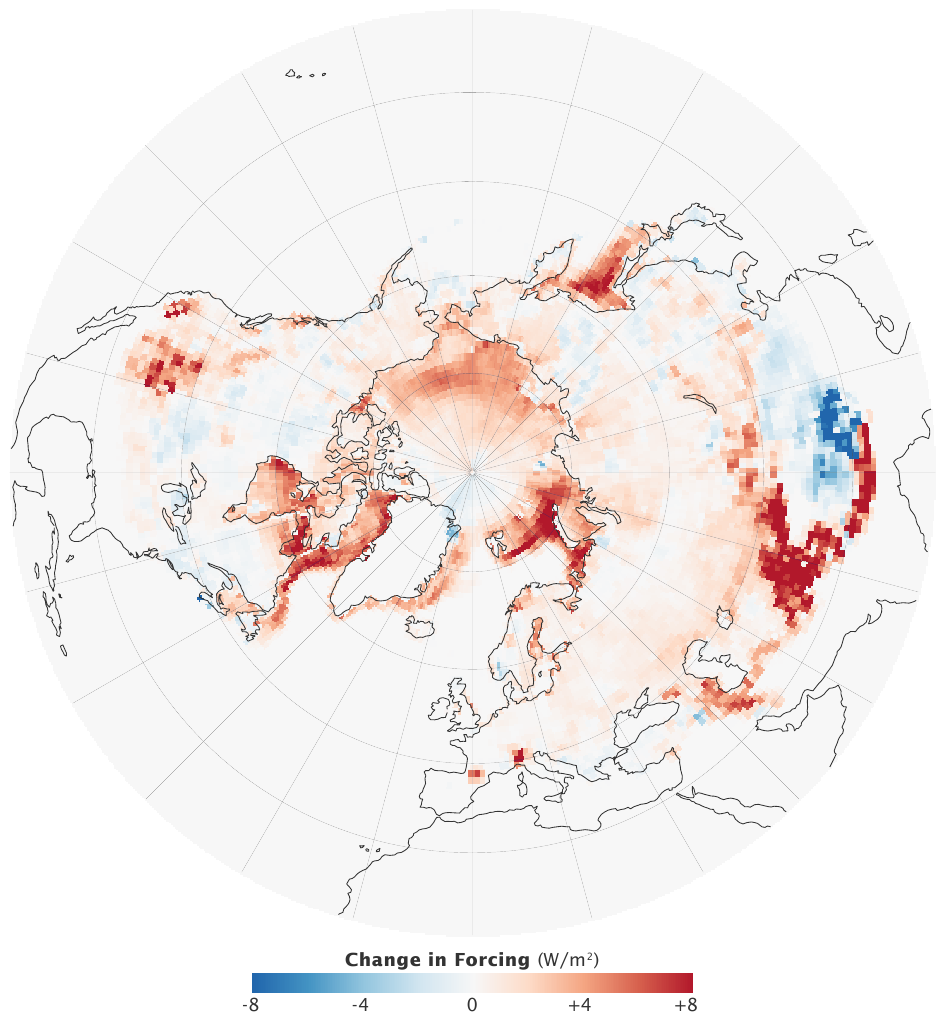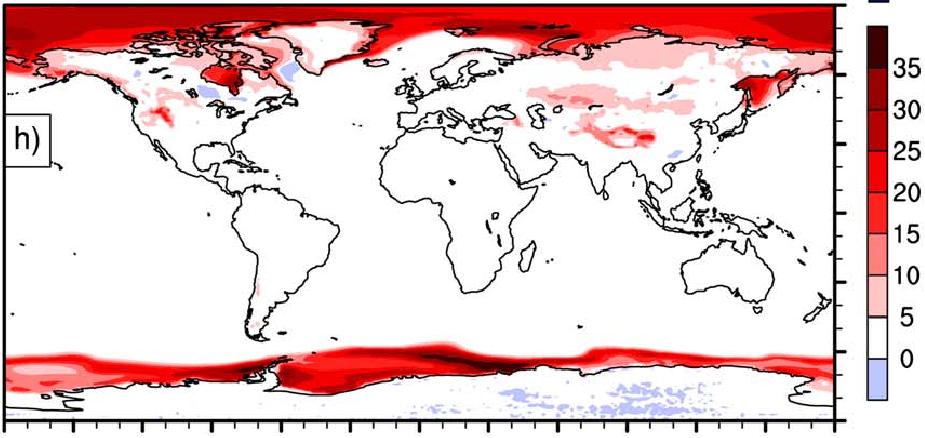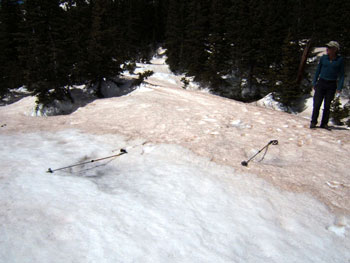Active areas of research include:
- Modeling and measuring radiative transfer in snowpack and quantifying effects of light-absorbing particles on snow albedo and metamorphism. Click here to run an online snow albedo simulator or download source code for SNICARv3, which includes new features such as snow algae, ice grains of different shapes, and carbon dioxide ice. (more)
- Improving modeling of algae impacts on surface albedo of the Greenland Ice Sheet (NSF funded project).
- Assessing volcano-climate interactions through Earth System Modeling (e.g., Flanner et al., 2014)
- Constraining and assessing impacts of short-lived climate forcing agents on Arctic climate.
- Understanding green light penetration in snow, ice, and supraglacial lakes to inform ICESat-2 surface altimetry retrievals (NASA-funded project).
- Quantifying Earth’s cryosphere radiative effect, constrained with observations and modeling. (more)
- Incorporating improved representations of far-infrared emission and scattering by snow surfaces and ice clouds in climate models (DOE-funded project with Xianglei Huang)
Other and previous areas of research include:
- Understanding impacts of biomass burning aerosol emissions on the Greenland Ice Sheet (NASA-funded project).
- Improving the simulated vertical distributions of aerosols in the Arctic (DOE-funded project).
- Constraining historical aerosol emissions using ice core records, combined with atmospheric transport and deposition modeling (NSF-funded projects).
- Building inventories of anthropogenic heat flux into climate model simulations (more).
- Understanding aerosol influence on carbon uptake in the Amazon.
Cryosphere forcing and albedo feedback
The presence of snow and ice increases the amount of solar energy that Earth reflects to space, thus cooling the planet. In a 2011 Nature Geoscience paper, we applied a variety of satellite observations to estimate that this additional reflected energy is between 2.2 and 4.6 W/m2, averaged annually over the Northern Hemisphere. This “cryosphere radiative effect” (CrRE) would be much larger (about double) without clouds, which partially mask surface albedo changes. The figure below from a NASA Earth Observatory feature shows the seasonal distribution of CrRE, where negative numbers indicate that snow and ice decreases absorbed solar flux by the planet. The season of peak CrRE is March–May, when the Northern Hemisphere has extensive snow and sea-ice cover and is exposed to relatively strong insolation.
In the same study, we also quantified the change in Northern Hemisphere CrRE (or cryosphere radiative forcing) between 1979 and 2008 (figure below), finding that the cooling effect of Earth’s boreal cryosphere decreased by about 0.45 W/m2. This change was mostly due to decreased land snow cover during the spring months (March–May), and decreased sea-ice cover during the spring and summer (April–July). Changes during these seasons are important because insolation is strong, meaning that a square meter of lost snow translates into a greater increase in absorbed solar energy than one lost during winter.
When we consider this surface darkening in the context of Northern Hemisphere warming over the same period, we derive a rather large estimate of the “cryosphere albedo feedback” – about 0.6 W/m2/°C in the Northern Hemisphere – indicating that snow/ice albedo feedback is a relatively strong positive feedback in the current climate.
This has helped motivate additional research into sources of model–observation discrepancies. To this end, we published a paper that incorporates an exact diagnostic model calculation of CrRE in the Community Earth System Model (CESM). We employed this diagnostic to find that Earth may absorb an additional 1.8 W/m2 of solar energy by the end of the century due to losses of snow and sea-ice, in response to continued growth of carbon dioxide emissions under the Representative Concentration Pathway (RCP) 8.5 scenario. The figure below shows the geographic distribution of the change in CrRE by 2100 simulated in one version of CESM (Perket et al, 2014)
Snow darkening from atmospheric particles
Very small (i.e., part per billion) concentrations of particles that absorb solar radiation (e.g., black carbon, mineral dust, and volcanic ash) can significantly darken snow surfaces (see below, or simulate it here). The resulting increase in absorbed energy can induce earlier melt and trigger snow albedo feedback, a positive feedback mechanism currently operating in Earth’s climate system. Changes in melt timing and magnitude also have important consequences for the 1+ billion people who rely on seasonal snow and glacier melt for water resources.
An important snowpack property that controls the magnitude of albedo reduction from impurities, and the albedo of the snow itself, is the effective grain size or specific surface area (i.e., the surface area of the ice crystals divided by their mass). Our research also examines factors that govern the time-evolution of this property, including the impacts of light-absorbing impurities. To study these processes, graduate student Adam Schneider has designed and fabricated an inexpensive instrument to rapidly and non-destructively measure surface snow grain size — the Near-Infrared Emitting and Reflectance-Monitoring Dome (NERD). We also develop and apply numerical models of radiative transfer and snow microphysics, and adapt them for suitable use in climate models. These tools help us quantify and constrain the strengths of cryospheric feedback mechanisms.
Below is the influence of 1 gram (about the mass of a paper clip) of black carbon dispersed on a square meter of snow at Niwot Ridge, Colorado:






